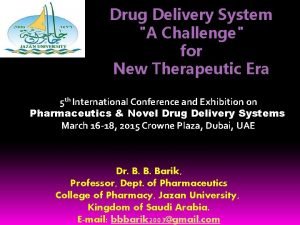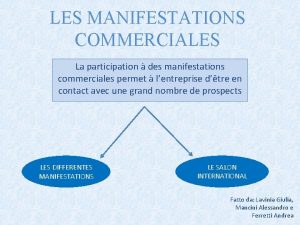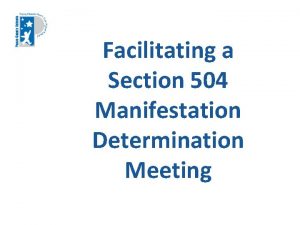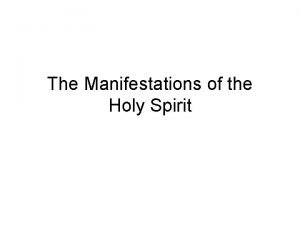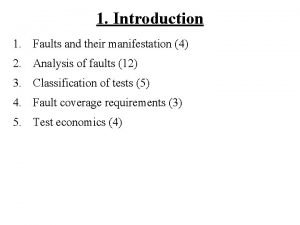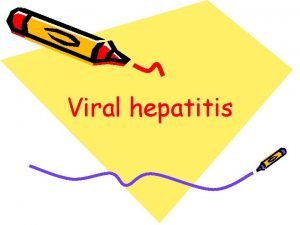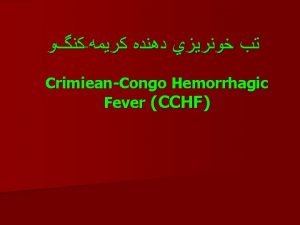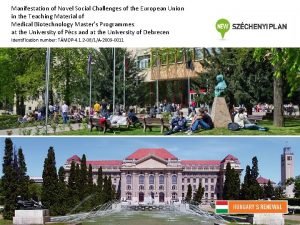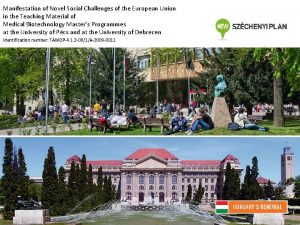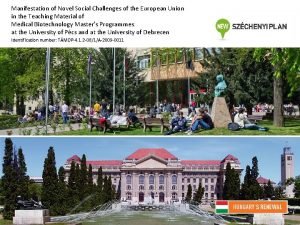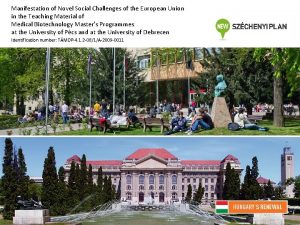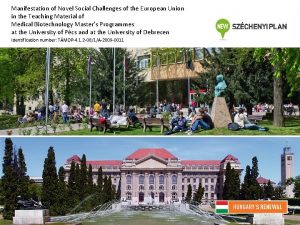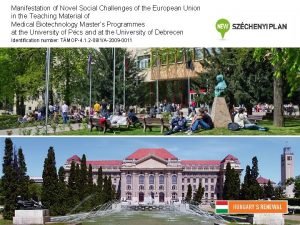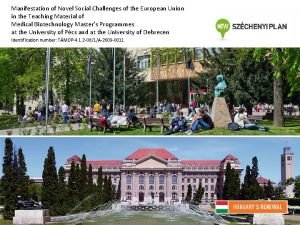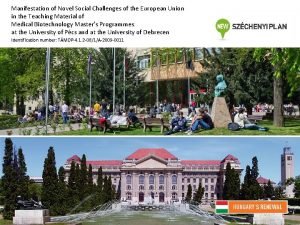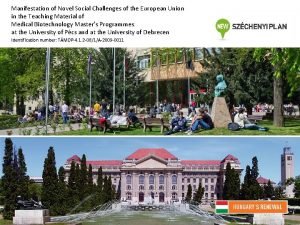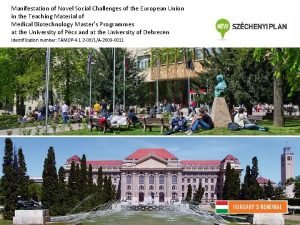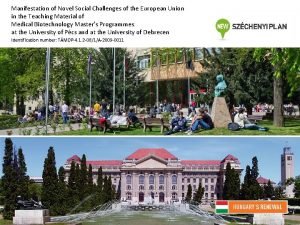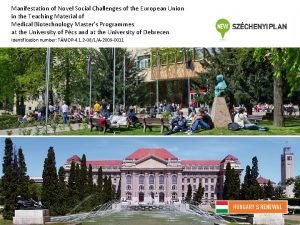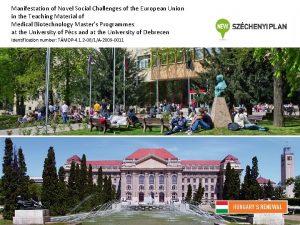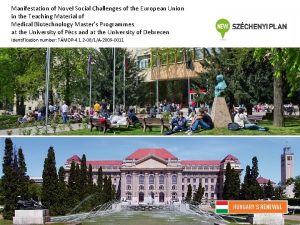Manifestation of Novel Social Challenges of the European
















- Slides: 16

Manifestation of Novel Social Challenges of the European Union in the Teaching Material of Medical Biotechnology Master’s Programmes at the University of Pécs and at the University of Debrecen Identification number: TÁMOP-4. 1. 2 -08/1/A-2009 -0011

Manifestation of Novel Social Challenges of the European Union in the Teaching Material of Medical Biotechnology Master’s Programmes at the University of Pécs and at the University of Debrecen Identification number: TÁMOP-4. 1. 2 -08/1/A-2009 -0011 Tímea Berki and Ferenc Boldizsár Signal transduction SECOND MESSENGERS

TÁMOP-4. 1. 2 -08/1/A-2009 -0011 Second messengers • Hydrophylic molecules: c. AMP, c. GMP, IP 3, Ca 2+ • Hydrophobic molecules (lipids): diacylglycerol (DAG), phosphatidylinositols • Gases: NO, CO, (H 2 S)

TÁMOP-4. 1. 2 -08/1/A-2009 -0011 General scheme of intracellular signaling Agonist activates membrane bound receptor G-protein is activated and produces effector Second messengers activates intercellular process Effector stimulates second messenger synthesis

TÁMOP-4. 1. 2 -08/1/A-2009 -0011 Discovery of second messengers - c. AMP • E. W. Sutherland • Adrenaline effect of the liver is mediated through cyclic. AMP • 1971. Nobel Prize in Physiology and Medicine

TÁMOP-4. 1. 2 -08/1/A-2009 -0011 Synthesis of c. AMP NH 2 N O O P O CH 2 O O P O O H H OH O O H O N H NH 2 N N N CH 2 H OH PPi ATP O Adenylyl cyclase O P O N O H OH c. AMP H N N NH 2 c. AMP phosphodiesterase H 2 O H N O O P O CH 2 O H N O H H OH OH N N H AMP

TÁMOP-4. 1. 2 -08/1/A-2009 -0011 c. AMP activates Protein kinase A Regulatory subunit c. AMP R C Catalytic subunit Inactive PKA c. AMP R C c. AMP Activated PKA

TÁMOP-4. 1. 2 -08/1/A-2009 -0011 PKA targets • • Enzymes Stucture proteins Transcription factors: CREB: dimeric form binds to c. AMP-responsive elements (CRE) CREB CRE

TÁMOP-4. 1. 2 -08/1/A-2009 -0011 Phospholipase C Hormone Plasma membrane Receptor PIP 2 a GTP b g DAG a PKC Cytoplasm PLC GTP G protein IP 3 Ca 2+ IP 3 opens Ca 2+ channel IP 3 R Ca 2+ Ca 2+ Lumen of smooth endoplasmatic reticulum

TÁMOP-4. 1. 2 -08/1/A-2009 -0011 IP 3 receptor pathway Hormone Ca 2+ channel Receptor Pump Plasma membrane Ca 2+ a GTP b g PIP 2 DAG a Cytoplasm PLC GTP G protein Ca 2+ IP 3 - + IP 3 R Ca 2+ Ca 2+ Lumen of smooth endoplasmatic reticulum Ca 2+ Pump

Gases as second messengers: NO way! TÁMOP-4. 1. 2 -08/1/A-2009 -0011 • “Endothelium-derived relaxation factor” (EDRF): mediator(s) produced by endothelial cells causing vasodilatation • 1980 s: NO!! [Nature 1983 Nov 10 -16; 306(5939): 174 -6. ] • 1992: NO: “molecule of the year” (Science); “Nitric Oxide Society” established • 1998: Nobel Prize in Physiology or Medicine – F. Murad, R. F. Furchgott, L. Ignarro, S. Moncada • ~3000 papers/year published about NO!

TÁMOP-4. 1. 2 -08/1/A-2009 -0011 NO synthesis NO synthase (NOS): 1 e. NOS: endothelial 2 i. NOS: inducible (eg. macrophages) 3 n. NOS: neuronal 2 major domains: 1 N-term. Oxygenase (Heme-thiolate proteins) 2 C-term. Reductase (~NADPH-cytochrome. P 450 reductase) 3 Linker: calmodulin-binding sequence NH 2 + H 2 N NH L-Arg NADPH + O 2 NADP+ HO NH 2 N NH + H 2 O + NH 3 O O – R H + NH 3 O O – H NOHLA 1/2 NADPH + O 2 O H 2 N + NO NH 1/2 NADP+ + H 2 O + NH 3 O O – H L-Citrulline

TÁMOP-4. 1. 2 -08/1/A-2009 -0011 NO-c. GMP pathway Vascular lumen Endothelial cell Acetylcholine Bradykinin L-arginine M Shear stress GTP Ca 2+↑ B 2 Smooth muscle cell e. Nos NO • GC c. GMP L-citrulline ONOO. OH NO • inactivation Oxidative stress Vasodilatation Platelet aggregation ↓ Smooth muscle growth ↓ Neutrophil adhesion ↓

TÁMOP-4. 1. 2 -08/1/A-2009 -0011 c. GMP

TÁMOP-4. 1. 2 -08/1/A-2009 -0011 Protein kinase G • Ser/Thr protein kinase activated by c. GMP • Expressed by vascular smooth muscle cells, platelets, endothel, heart muscle, fibroblasts, renal cells, leukocytes, nervous system • Regulates smooth muscle relaxation, platelet function, sperm metabolism, cell division and nucleic acid synthesis

TÁMOP-4. 1. 2 -08/1/A-2009 -0011 Functions of NO • Vascular effect: vasodilatation – e. g. Nitroglycerin: treatment of coronary disease (Angina pectoris) – e. g. Viagra: erection • Heart: contractility and heart rate ↓ • Immune system: macrophages produce NO to kill bacteria BUT in severe systemic infection (Sepsis) this leads to generalised vasodilatation and SHOCK (Septic shock)
 Challenges of novel drug delivery system
Challenges of novel drug delivery system Vocabulaire de l'étonnement
Vocabulaire de l'étonnement Manifestation commerciale exemple
Manifestation commerciale exemple Manifestation meeting for 504
Manifestation meeting for 504 Canvas.aps
Canvas.aps Manifestation determination flowchart
Manifestation determination flowchart Rayon rubis doré
Rayon rubis doré The manifestation of the holy spirit
The manifestation of the holy spirit Manifestation de dépendance des 14 besoins fondamentaux
Manifestation de dépendance des 14 besoins fondamentaux Manifestation determination process
Manifestation determination process Fault is manifestation of which defects
Fault is manifestation of which defects Manifestation names
Manifestation names Neonatal jaundice
Neonatal jaundice Deity titles
Deity titles Hemorrhagic
Hemorrhagic Vocabulaire manifestation
Vocabulaire manifestation Sunnatullah in human life
Sunnatullah in human life
